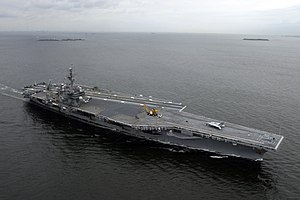
Back Třída Kitty Hawk Czech Kitty-Hawk-Klasse German Clase Kitty Hawk Spanish Kitty Hawk -luokka Finnish Classe Kitty Hawk French Nosači zrakoplova klase Kitty Hawk Croatian Kapal induk kelas Kitty Hawk ID Classe Kitty Hawk Italian キティホーク級航空母艦 Japanese 키티호크급 항공모함 Korean
 USS Kitty Hawk conducting sea trials in the Western Pacific Ocean, May 2006
| |
| Class overview | |
|---|---|
| Name | Kitty Hawk class |
| Builders | |
| Operators | |
| Preceded by | Forrestal class |
| Succeeded by | Enterprise class |
| Subclasses | John F. Kennedy class (variant) |
| In commission | 21 April 1961 – 31 January 2009 |
| Completed | 3 plus 1 variant |
| Laid up | 1 |
| Scrapped | 2 plus 1 scuttled |
| General characteristics | |
| Type | Aircraft carrier |
| Displacement |
|
| Length |
|
| Beam |
|
| Draft | 38 ft (12 m) |
| Installed power | 280,000 shp (210 MW) |
| Propulsion |
|
| Speed | 32 kn (59 km/h; 37 mph) |
| Range | 12,000 mi (19,000 km) |
| Complement | 5,624 |
| Armament |
|
| Aircraft carried | Up to 90 aircraft |
The Kitty Hawk-class supercarriers of the United States Navy were an incremental improvement on the Forrestal-class vessels. Three were built, all in the 1960s, Kitty Hawk (CV-63) (1961–2009), Constellation (CV-64) (1961–2003), and America (CV-66) (1965–1996), as well as the variant John F. Kennedy (CV-67) (1967–2007). All are now decommissioned.